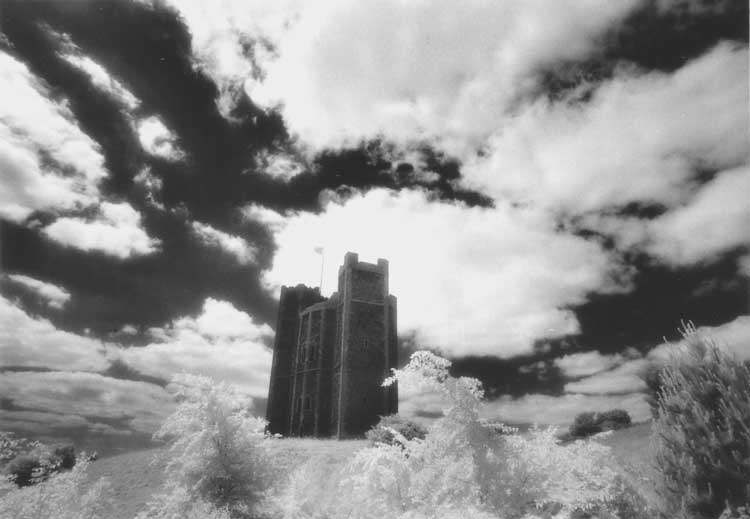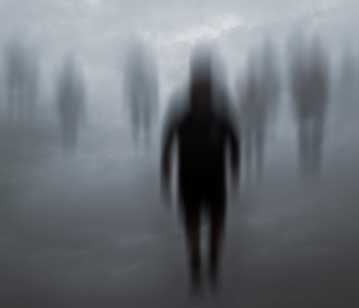
A Roundup Of Suffolk Ghosts And Legends
Potsford Wood
Potsford Wood is a creepy eerie place even on the brightest of summer days.
Almost lost amidst its creeping carpets of nettle and bracken are the decaying remains of the Potsford Gibbet, last used on 14th April 1699 when Jonah Snell was executed for murder.
The secluded wood is a truly frightening place to be on wild, winter nights. The skeletal trees stand gaunt and shadowy, their branches reaching out to grip one another in grim embrace.
Locals speak in hushed tones of strange lights that twinkle from the depths of the wood.
Strangers talk of a fearsome choking groan that that sounds alongside them.
Some who have paused to gaze upon the rotting remains of the old gibbet, have turned to find a mysterious figure in black standing behind them, and are horrified to see that beneath its dark cloak there is nothing more than a grimacing, hollow - eyed skull staring at them.
Dunwich - The Town that Vanished
What was once the sixth largest town in England, is now little more than a tiny, atmospheric, sea-side village and to stride along the shoreline at twilight is to feel the true thrill of Haunted England.
The gulls wheel about you, their raucous cries intermingling with the thunderous percussion of the crashing waves.
Legend speaks of these birds being the souls of long dead fishermen.
History tells that their once great town of Dunwich now lies submerged beneath the foaming waters of the very sea that stretches out before you.
But in a quiet moment when the gulls fall silent , and the wild waves retreat to prepare their next assault , you may hear the ghostly bells of the towns churches tolling their mournful knell from beneath the swell, their dull melodies drifting with the mists upon the sea breezes.
You may even see the swirling shapes of long dead citizens drifting across the cliff tops. And you will know in that moment of peace and quietude, that you have walked with ghosts on Dunwich shore.
The Swan, Lavenham, Suffolk
Lavenham is one of the most beautiful towns in Britain, and is widely regarded as one of the finest examples of a medieval municipality.
The Swan Inn, parts of which date back to 1425, is without doubt one of its chief glories. It is an archetypal medieval inn, with a timbered exterior and beamed ceilings and ancient walls reminiscent of a bygone age.
During World War II its Garden Bar was a great favourite with American airmen stationed nearby, and many of their signatures are scrawled across the walls of the bar.
Glen Miller, the bandleader, is even said to have stopped in for a drink before setting out on his last fateful flight.
However, the building' s benign ghost dates back to the 19th century when The Swan was in its heyday as a coaching inn and boasted stabling for over 50 horses.
What is now room 15 was, in those days, occupied by a housekeeper. It is said that she fell pregnant out of wedlock, and although the man responsible agreed to marry her, he had a last-minute change of heart and left her standing at the altar.
Another version of the tale claims that she became depressed when she was overlooked for a promotion. Whatever the cause of her despondency, the outcome was the same: the poor woman hanged herself from one of the rafters in her room.
Her ghost has remained behind to chill the blood of those who cross her path. A security guard encountered her in 1991 and was scared half out of his wits. Several guests have also seen her melancholic wraith in room 15, and a nun who was staying here one night awoke with a start in the early hours when the ghost began tickling her feet!
The Crown Inn, Bildeston, Suffolk
The timeless aura that descends upon you as you enter this 15th century inn, with its inglenook fireplace and low beams, is quaintly reminiscent of a bygone and long lost age.
Sitting in its snug and atmospheric bar, listening to the low murmur of the conversation, it is easy to close your eyes and cast your imagination back over the literally thousands of events to which its ancient walls must have borne witness.
There was the infamous election campaign of 1855, when the Crown was being used as a political headquarters by one of the candidates and rival supporters attacked the inn. They shattered the windows, smashed crockery and broke many of the drinking vessels until, their frustrations vented, they proceeded with a noble attempt to drink the pub dry!
If your mind ventures back further into the foggy mists of time you can imagine the excited wool merchants' family, for whom the property was first built, moving in to their brand new home in the year 1495. And, on opening your eyes, you may just catch a fleeting glimpse of one of the many ghosts that flit about its rooms.
A mysterious grey lady has been seen at a window that looks out onto the car park waving a ghostly farewell to departing customers.
Two children dressed in Victorian outfits have appeared before startled guests at various points around the Inn, whilst an old man in a tri-cornered hat is frequently seen sitting in a favoured corner of the main bar.
For those who enjoy a smattering of haunted hospitality, Room four is the bedroom where guests often experience things going bump in the dead of night.
They may be treated to an appearance of the grey lady, or of the "genial missionary" whose presence several visiting mediums have detected.
And if neither of these is sufficient to aid a decent nights unrest, there is always the touch of ice-cold fingers that have been known to stroke the necks of sleeping guests.
The Mill Hotel, Sudbury, Suffolk
The hotel stands over the river which once drove the mighty wheel that can still be seen encased behind glass in the restaurant.
When the building was a mill a lady is said to have drowned beneath the wheel and her ghost still haunts the older sections of the hotel.
Cleaning staff will not venture alone into some of the older rooms, and those who find themselves alone in the restaurant late at night can find it an unnerving experience.
Displayed beneath the floor in the hotel foyer lie the mummified remains of a cat, its facial features frozen in an eternal snarl.
Bricked up to bring good luck to the original mill building, it was rediscovered in 1971 when the mill was converted to a hotel. Whenever the cat is removed from the hotel a spate of bad luck always follows.
In 1999 the cat was removed. Over the next few weeks the Road outside the hotel exploded, the managers office flooded several times and the person who had removed the cat met with an accident.
All returned to normal once the mystic mog had been returned.
The Abbey Ruins, Bury St Edmunds
The passage of time has left the once proud arches of what must have been a magnificent Abbey, mouldering in decay.
Its haunting buttresses have tottered and fallen. Its stark stone columns now loom over eerie crumbling walls, whilst hollow windows look mournfully down on the shattered cloisters and scattered aisles where monastic feet once shuffled in peaceful contemplation.
But when the glint of a full moon casts dancing shadows across the ruins, ghostly monks have been known to walk amidst the once proud walls or to stand silently by the old gatehouse of what is acknowledged to be one the most spiritually charged locations in England.
Potsford Wood
Potsford Wood is a creepy eerie place even on the brightest of summer days.
Almost lost amidst its creeping carpets of nettle and bracken are the decaying remains of the Potsford Gibbet, last used on 14th April 1699 when Jonah Snell was executed for murder.
The secluded wood is a truly frightening place to be on wild, winter nights. The skeletal trees stand gaunt and shadowy, their branches reaching out to grip one another in grim embrace.
Locals speak in hushed tones of strange lights that twinkle from the depths of the wood.
Strangers talk of a fearsome choking groan that that sounds alongside them.
Some who have paused to gaze upon the rotting remains of the old gibbet, have turned to find a mysterious figure in black standing behind them, and are horrified to see that beneath its dark cloak there is nothing more than a grimacing, hollow - eyed skull staring at them.
Woolpit, Suffolk - The Green Children
The sign of this peaceful little village, in the heart of rural Suffolk, commemorates one of the most curious legends to emerge from the mists of medieval history.
The story was chronicled by two 13th century clerics, Ralph, Abbot of Coggleshall and William of Newburgh and tells how one summer, during the reign of King Stephen (1135-1154), farm workers bringing in the harvest from the fields that surround the village, were suddenly surprised by the sight of two strange figures emerging out of the pits from which the village takes its name.
They were a boy and girl whose skins were completely green. They wore strange looking clothes, could not understand anything that the villagers said to them but seemed able to converse with each other in a strange, unintelligible tongue.
The bemused villagers took the children to the home of the local landowner, Sir Richard de Calne. They refused to eat any food until some green beans were offered them and these they consumed hungrily.
The boy soon died, but the girl quickly settled into her new surroundings where, having adapted to a normal diet, her skin gradually lost its green hue and she became like any other woman.
She was soon able to converse in English and answer the questions that her hosts were eager to ask. She said that she and her brother had dwelt previously in a place called St Martin's land, where the sun never shone. Its residents, she said, lived in perpetual twilight, although they could see another "land of light" across a river.
One day, she and her brother had been tending their father's sheep, when they heard the beautiful sound of bells and had entered an underground passageway in search of their source. Emerging from the darkness, they had been overcome by a dazzling light and had lain motionless for a time. Startled by those who found them, they had attempted to escape, but were unable to find the entrance to the cavern again and so had been brought to the house where she now resided.
In time, the girl married a man from Kings Lynn, and went on to live a long and happy life, leaving behind her a curious enigma over which people have been arguing and pondering ever since.


